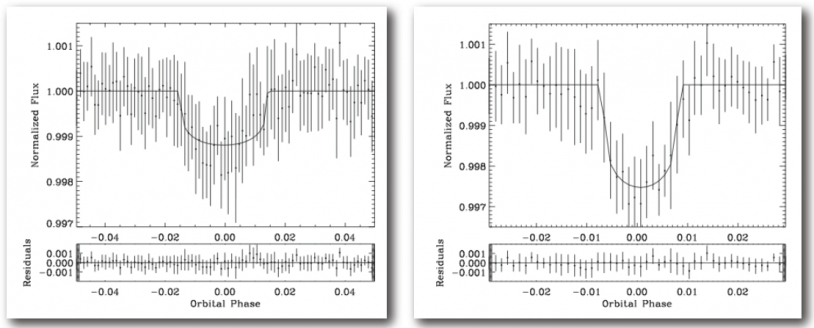More than 550 exoplanets were detected, among which 25 by CoRoT. They are much more divers than we ever expected. Some take several years to orbit their parent star, whereas others actually make it in less than one day. They can be of all sizes, from giant gaseous planets twice bigger than Jupiter to smaller ones like Earth.
CoRoT, a CNES' satellite, was the first space mission designed to find extrasolar planets. After orbiting for 4 years, it already detected 401 planet candidates among which many are currently being investigated in order to learn more about their true nature. CoRoT uses the transit method, simultaneously monitoring tens of thousand stars and detecting very small and periodic occultations resulting from a planet passing in front of its host star. The transits allow astronomers to measure the planets' radius and are being completed by ground observations to pinpoint their masses.
The 10 new confirmed planets were named from CoRoT-16b to 24b and c. Seven are hot Jupiters, some with exceptionally high densities and/or elliptic orbits, and one is orbiting an exceptionally young star. There is so much to learn about the way the giant planets' formation and evolution thanks to those planetary systems. The announcement also included a slightly smaller planet than Saturn and two "Neptune-like" planets orbiting the same star. Only a few similar planets were already characterized and that is why they are particularly interesting.
Some details about the new confirmed planets:
- CoRoT-16b: a giant inflated planet with a short orbital period. Compared to Jupiter, it has the same size and half its mass. It takes 5.3 days to orbit a 6 billion year old star. The orbit of this planet is eccentric, which is very rare for such a old and tight planetary system.
- CoRoT-17b: a massive giant planet orbiting a 10 billion year old star, twice the age of our Sun. It takes 3.7 days to orbit its star and weights 2.4 times more than Jupiter, having twice the density of Jupiter. The observation of such a old planetary system is important in order to understand the long-term evolution of the giant planets.
- CoRoT-18b: the orbital period of this hot Jupiter is 1.9 days and is in the plane of the Equator of its host star. This planet is 1.4 times bigger than Jupiter and 3.5 times heavier. It is thus denser than Jupiter.
- CoRoT-19b: a planet with the same mass than Jupiter but 1.5 times bigger. It has a lower density than Saturn, the less dense planet of our solar system.
- CoRoT-20b: an eccentric orbited hot Jupiter which takes 9.2 days to orbit its star. CoRoT-20b is special because of its very eccentric orbit which can result from its very high density, twice as much as Mars, even if it is a giant gaseous planet.
- CoRoT-21b: a giant gaseous planet 1.3 times bigger and 2.5 times heavier than Jupiter. It is one of the weakest star observed by CoRoT for which the masses was pinpointed. Those measurements required to use the Keck 10m telescope of Hawaii.
- CoRoT-22b: the size of the planet is 0.62 time the Saturn's radius. The mass of this exoplanet still has to be accurately pinpointed but it is probably less than half the Saturn's.
- CoRoT-23b: a hot Jupiter with an orbital period of 3.6 days and an unexpected eccentric orbit.
- CoRoT-24b and 24c: a system with two transiting planets which are the same size than Neptune and have orbital periods of 5.1 and 11.8 days. The planets' radius are 4.2 and 2.7 Earth radius respectively.
Contacts
- Scientific contacts: Magali Deleuil, Claire Moutout, Thierry Botti, LAM (Laboratoire Astronomique de Marseille)
- CoRoT principal investigator: Annie Baglin, Observatoire de Paris
- Astrophysics program scientist: Olivier La Marle
